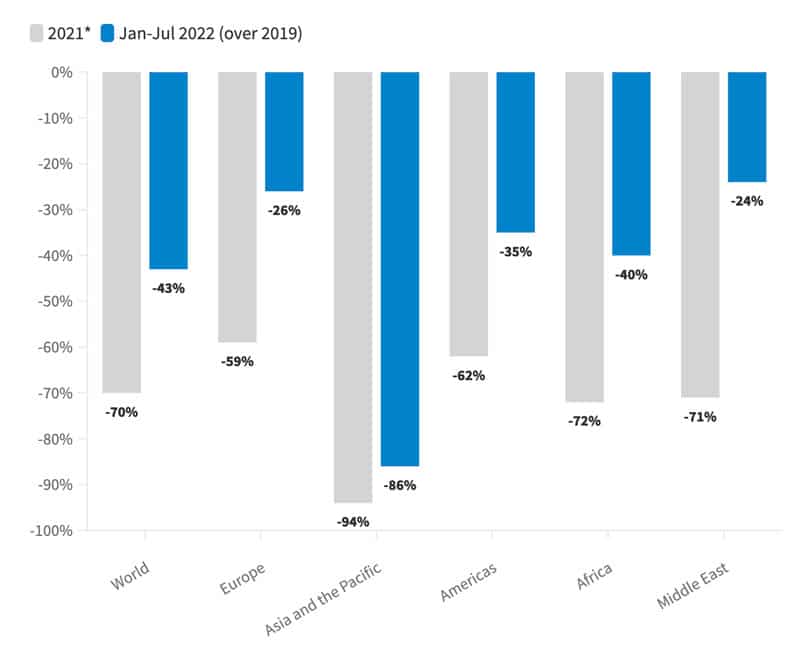Global tourism has recovered to roughly 60% of pre-pandemic levels
- Global tourism picked up nicely in the first half of 2022, with Europe and the Middle East the closest of all world regions to pre-pandemic levels of international arrivals
- However, the UNTWO cautions that economic and geo-political factors are worrying in terms of the continued recovery of global tourism
- A global recession would increase students’ need for affordable study abroad options, possibly including an online start to programmes from their own country
International tourism is not yet back to pre-pandemic levels, but it is getting there. From January to July of 2022, the number of international arrivals was 172% higher than in the same period in 2021. In all, about 60% as many people were travelling internationally in the first half of 2022 as compared to 2019. Roughly 474 million tourists travelled to other countries January-July 2022, compared with 175 million in those same months in 2021.
The UNTWO comments:
“The steady recovery reflects strong pent-up demand for international travel as well as the easing or lifting of travel restrictions to date (86 countries had no COVID-19 related restrictions as of 19 September 2022).”
At the same time, the organisation notes that there are dampers on the recovery of global tourism – “from geopolitical to economic.” On 4 October 2022, the UN warned that the world “is on the brink of a recession” due to factors such as interest rate hikes in advanced economies.
Time for a “rethink”
Now is the time to rethink tourism, says the UNTWO, given its impact on “people and the planet.” Many students would agree. A study by QS in 2019 suggested that there is demand for schools and universities to become more environmentally conscious. More than 9 in 10 students surveyed said that “universities could do more to reduce their own impact on the environment.” In addition, more than three-quarters (79%) said they would be “more likely to choose a degree if the content taught them about reducing their environmental impact.”
Regions leading the recovery
The greatest recovery in arrivals occurred in Europe and the Middle East, where arrivals reached 74% and 76%, respectively, of their levels in 2019. Growth in Europe was driven by travel from within the region as well as from the US.

Who’s spending the most?
In terms of source countries for tourism, tourists from France and Germany spent almost as money on travel in the first part of 2022 as in the same period in 2019 (off only -12% and -14%, respectively). Travellers from Italy and the US also picked up their expenditures on travel, spending about three-quarters as much as they were before the pandemic.
A cautious outlook
Russia’s war on Ukraine is having a major impact on the rest of the world, dragging down both advanced and emerging economies. The UNTWO elaborates:
“The economic situation, exacerbated by the aggression of the Russian Federation against Ukraine, represents a major downside risk. The combination of increasing interest rates in all major economies, rising energy and food prices and the growing prospects of a global recession as indicated by the World Bank, are major threats to the recovery of international tourism through the remainder of 2022 and 2023.”
That warning should resonate with educators recruiting international students, as well. Throughout the year, we have reported on students’ growing interest in for study abroad options that are relatively affordable. This is leading to growth in international student numbers in several countries outside the leading English-speaking destinations (e.g., Germany, France, Spain, and Finland).
Students may also be more likely to consider online starts to their programmes, given that by staying in their own countries for part of their degree they would avoid a portion of accommodation and living costs in a destination country. Demand for this option may increase if students are provided with additional incentives, such as lower tuition or post-study work rights. An IDP study in 2021 found that significant proportions of students in 55 countries would consider an online start to studies.
Demand for purely online studies may rise as well. This is already a trend in many regions. In Japan, for example, of the 15,100 Japanese students who enrolled in foreign institutions in 2021, according to JAOS (Japan Association of Overseas Studies), just over 6,100 went abroad, while nearly 9,000 stayed in Japan to study online.
For additional background, please see:















